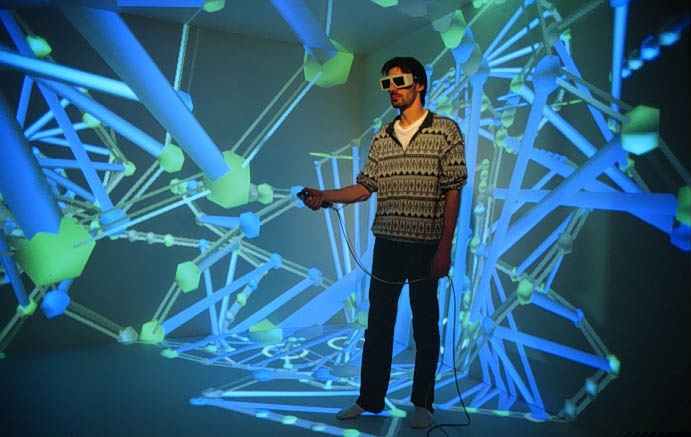VR-Cube
In the autumn of 1998, a six-sided virtual reality (VR) cube was built at PDC to provide an immersive visualisation environment. It was essentially a room that was used to display computer generated stereoscopic 3D images. The VR-cube was a development of the original cave automatic virtual environment (CAVE) design that was created in the Electronic Visualization Laboratory at the University of Illinois in Chicago by Carolina Cruz-Neira, Dan Sandin, and Tom DeFanti. The KTH VR-cube at PDC gave a realistic experience of actually being immersed in a virtual world and was the first facility in the world to have projection on all six surfaces of the cube, that is, onto the floor and ceiling of the room, as well as onto the four walls. It also had a unique 3D sound capability.
The VR-cube was built by TAN Projectionstechnolgie from Germany. It was a 3m × 3m × 2.5m (W × D × H) room that was powered by a Silicon Graphics Onyx2 with twelve R10000 processors and three Boye graphics pipes. The system tracked the users' positions and angles of sight, and the images that were projected onto the six surfaces were adjusted accordingly. Each of the graphics pipes managed two of the six surfaces. The floor and ceiling were configured for a resolution of 1024 × 1024 pixels at a frequency of 96 Hz (that is, 48 Hz per eye, due to stereo projection). The walls were configured for a resolution of 1024 × 852 pixels to keep the pixels square and to keep the resolution constant along the edges.

Potential uses for the VR-cube ranged from fields like academic and industrial scientific research to urban planning, architecture and art. The VR-cube was made available to academic researchers and commercial enterprises throughout Sweden, and as many as ten people could stand in the CUBE at a time. “Virtual reality gives industrial scientists the ability to work with complicated processes more easily,” said P. G. Hedstrom, chair of the PDC board of directors at the time. “This immersive visualisation environment allows a large number of people to simultaneously view scientific processes. Research findings can be viewed by a group, rather than only by one individual at a time, which facilitates more meaningful discussions among researchers. This is a tool that can have an enormous impact both in academia and industry.”
After being inaugurated in 1998 by the King of Sweden, the VR-cube soon became a major attraction for visitors to KTH. The cube was used both for scientifc visualisation and by artists and designers. For ten years until 2008 the cave was used in a number of projects: some were projects of a scientifc nature and others were more artistic. The VR-cube was shut down 2008 as the technology was becoming old and the cost of operating the gigantic installation had become too high.
A retrospective seminar about the VR-cube and its use by artists was held in 2016, which aimed to summarise the ten years of experience of the scientists and engineers collaborating with artists on projects involving the VR-cube. The seminar ended with an open discussion on how to promote collaboration between science and art in the future.
